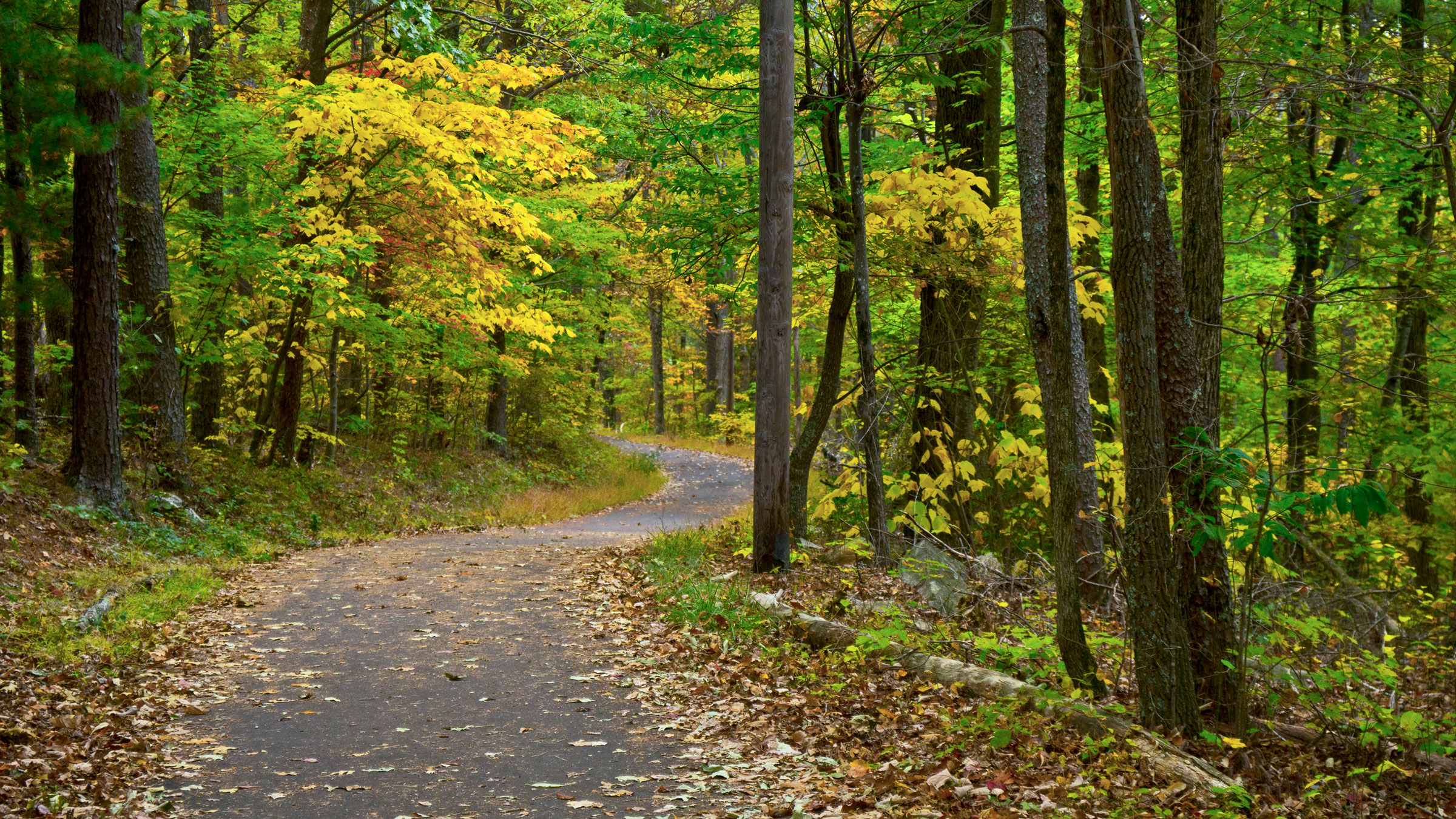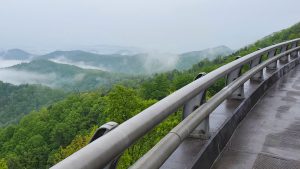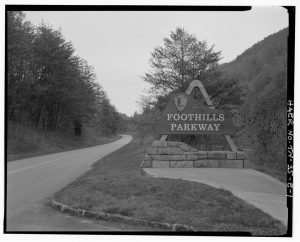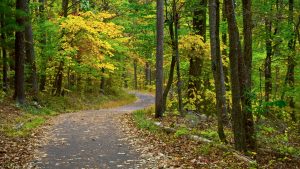
After several years of closure due to lack of funding, Great Smoky Mountains National Park recently opened new, improved versions of the Look Rock campground and picnic area. And just in the nick of time. Located on the Foothills Parkway West, this off-the-beaten path area of the national park offers a welcome reprieve from busier places like Cades Cove and Clingmans Dome. Improvements to the campground and picnic area include power and water hookups, new tables and fire rings, and better accessibility for people with disabilities.

The facilities at Look Rock and the Foothills Parkway were conceived some 70 years ago when people had already started griping that our national parks were overcrowded and underfunded. The National Park Service now refers to this period as “The Poverty Years,” and the reasons for the funding drought were obvious: During World War II, the United States government diverted the bulk of its spending toward the war effort.
When World War II ended in 1945, Americans celebrated by hitting the road like never before. Gas was cheap, and industrialization and the booming economy allowed more and more families to own one of the era’s big, bulbous automobiles. People wanted to see the snowcapped mountain peaks and red rock canyons that beckoned in magazines.
America’s national parks were not ready for the onslaught. The country was deeply in debt after the war—Congress kept a tight leash on domestic spending, and cuts to parks remained. Meanwhile, in the Smokies, visitation surged from 534,000 in 1944 to 2.5 million in 1954. Nationwide, the flood of park visitors was even more overwhelming, increasing from 7.7 million to 48 million. In the media, the park service, and in Washington, DC, people were concerned Americans were “loving our parks to death.”
On January 27, 1956, NPS Director Conrad Wirth stood before President Dwight Eisenhower and his cabinet to propose a big, bold, and expensive ten-year plan to meet the needs of the mushrooming numbers of visitors to national parks. Wirth’s key goals were to break up traffic jams, upgrade visitor services, enhance park protection, and offer better housing to boost staff morale. The effort, dubbed Mission 66, would begin immediately and conclude in time for the park service’s 50th anniversary in 1966.

Back in the Smokies, local citizen groups and park officials were likewise bemoaning the tsunami of visitors and paucity of rangers, naturalists, campgrounds, and visitor centers. They wanted to ease congestion with major improvements to Newfound Gap Road and a bypass road around Gatlinburg, Tennessee. Officials expressed concern that over 3,000 people a day were crowding into the tiny Oconaluftee museum, located in the lobby of the administrative building, and that visitors suffered “traffic jams, bumper to bumper travel and mental conditions not conducive to the appreciation of park values.”
Mission 66 granted many, though not all, of the park’s wishes. The park got Sugarlands Visitor Center, but Oconaluftee would have to wait until 2011, when Smokies Life (then Great Smoky Mountains Association) funded construction of a new building. Clingmans Dome tower was replaced, Mingus Mill restored, and new staff housing added at Oconaluftee, park headquarters, Elkmont, and elsewhere. Additional rangers and maintenance workers were hired, and a section of the Foothills Parkway, which included the campground, tower, and picnic area at Look Rock, was built.
The Walland-to-Look Rock section of the Foothills Parkway opened to a line of waiting vehicles at 8 a.m. on September 3, 1965. Other than “The Spur” connecting Pigeon Forge and Gatlinburg, it was the first section of the parkway to be completed. The Look Rock campground and picnic area opened the following day and were reported to be full for the Labor Day weekend. The trail and observation tower at Look Rock were finished in 1967.
The Foothills Parkway and Look Rock facilities fit the Mission 66 goal of improving traffic circulation in the heart of the park. They were also congruent with another growing concern during the period: shunting visitors away from the park’s wilderness core and encouraging infrastructure development and visitor use along the fringes. In other words, if visitors were enjoying beautiful views of the Smokies from the Foothills Parkway, they wouldn’t be stuck in traffic at Cades Cove or Clingmans Dome.

Look Rock had been a popular place to enjoy views of the Smokies and the Great Valley of East Tennessee long before the observation tower was constructed in 1967. Guests from the Montvale Springs Hotel, at the base of Chilhowee Mountain, frequently made the ritual three-mile hike over “primitive trails” to the 2,657-foot vantage point. The hotel dated back to 1832, when its abundant sulfuric spring waters were touted as “fountains of youth and health,” and it attracted an eclectic mix of celebrities before burning down in 1933. Afterward, the Look Rock area was left to loggers, hunters, livestock herders, and seasonal fire lookouts until its revival as a tourist destination with the opening of Foothills Parkway West.
Look Rock’s famous views, especially at sunrise and sunset, and during fall color season, continued to make it a popular destination with both locals and the traveling publc. However, in 2013, during another lean period for federal budgets known as “sequestration,” the NPS closed the Look Rock campground and picnic area, along with Abrams Creek and Balsam Mountain campgrounds, citing the need for extensive upgrades to its water system.
In late 2018, the tide began to change when the NPS opened a long-awaited 16-mile section of the Foothills Parkway between Wears Valley and Walland. Combined, the old and new sections now formed a 33-mile ridgetop drive void of billboards, traffic lights, utility lines, and commercial traffic but loaded with 80-mile views and the beauty of the Great Smoky Mountains. At the opening, Superintendent Cassius Cash called the Foothills Parkway “one of the most scenic drives in America.”
Afterward, the NPS began shifting about for funding to reopen Look Rock. Between monies from park partner Friends of the Smokies, park fees, and federal matching grants, the park service was able to reopen Look Rock Picnic Area in 2019 and Look Rock Campground in 2022. Funding from the Great American Outdoors Act allowed the NPS to repave the entire 17-mile Walland-to-Chilhowee Lake section of the parkway.
“The park is thrilled to have campers back at Look Rock,” said Barbara Hatcher, the park’s chief of facility management. The area offers “a grand display of fall colors,” and showcases “Mother Nature at her finest.”

There was another impetus for reopening Look Rock: While the campground and picnic area were closed, visitation to the park spiked by around 40 percent. The overcrowding in the core area of the national park prophesied during the Mission 66 years—when annual visitation to the Smokies was 2.9 million compared to today’s 13.3 million—had come to pass. Currently, safety valves like the Foothills Parkway are increasingly valuable for visitors looking to dodge the traffic and crowds. Look Rock provides “opportunities for less crowding and a little more secluded campsites,” Hatcher said.
Many improvements were bestowed upon Look Rock prior to its reopening, including power and water hookups for ten recreational vehicle sites—making it the first campground in the Smokies to offer such amenities. All the campground’s waterlines were replaced, and most power lines buried. The campground now includes accessible restrooms and picnic tables for people using wheelchairs.
“We are getting ready to convert a couple of tent sites to meet accessibility standards,” Hatcher said, adding that “the trees provide a lot of shade and privacy.”
At 2,657 feet of elevation atop 35-mile-long Chilhowee Mountain, with its cool summer breezes and a press box view of the Smokies, Look Rock is a beautiful place to hike, picnic, sunrise, or camp. The observation tower is open year-round unless the parkway is closed because of weather. The campground and picnic area, 18 miles southwest of Townsend, Tennessee, on the Foothills Parkway West, are open from late April through late October. Learn more at recreation.gov.
Subscribe to get the latest posts sent to your email.
The Great Smokies Welcome Center is located on U.S. 321 in Townsend, TN, 2 miles from the west entrance to Great Smoky Mountains National Park. Visitors can get information about things to see and do in and around the national park and shop from a wide selection of books, gifts, and other Smokies merchandise. Daily, weekly, and annual parking tags for the national park are also available.